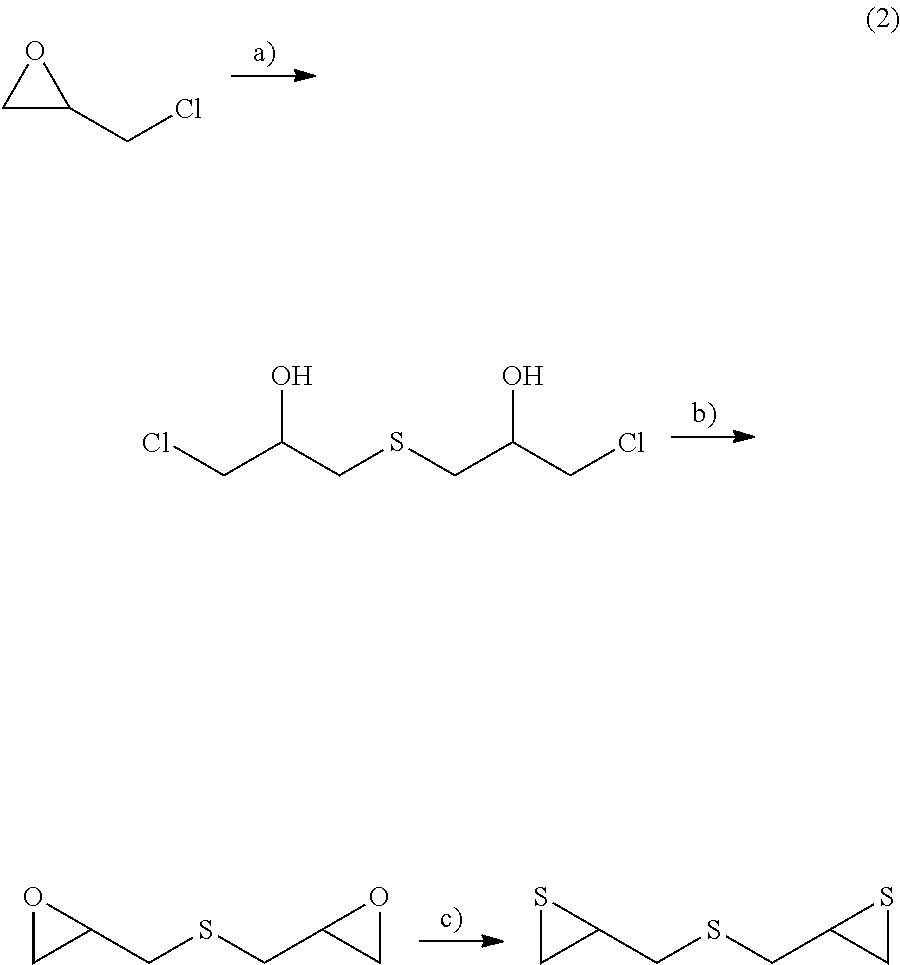Polymerizable composition for optical material and optical material
a technology of optical materials and polymerizable compositions, applied in the direction of lenses, spectales/goggles, instruments, etc., can solve the problems of no studies being carried out regarding the use of optical materials, and achieve excellent balance between transparency, heat resistance, and dyeing properties
- Summary
- Abstract
- Description
- Claims
- Application Information
AI Technical Summary
Benefits of technology
Problems solved by technology
Method used
Image
Examples
examples
[0191]Hereafter, the present invention will be described in more detail using examples, but the present invention is not limited thereto. In the following description, unless otherwise particularly stated, “parts” and % are based on a weight.
[0192](Method for Measuring the Concentration (%) of Unreacted 1,5-Pentamethylene Diisocyanate in Polyisocyanate (1) which is a Composition Including a Modified 1,5-Pentamethylene Diisocyanate)
[0193]The concentration of unreacted 1, 5-pentamethylene diisocyanate in polyisocyanate (1) including a modified product was obtained from standard curves produced using 1,5-pentamethylene diisocyanate obtained in Preparation Example 4 described below as a standard product and the following device.
[0194]Device: Prominence (manufactured by Shimadzu Corporation)
[0195]Column: SHISEIDO SILICA SG-120
[0196]Column temperature: 40° C.
[0197]Eluent: n-Hexane / methanol / 1,2-dichloroethane=90 / 5 / 5 (volume ratio)
[0198]Flow rate: 0.2 ml / min
[0199]Detector: UV 225 nm
[0200]R....
reference preparation example
Synthesis of 1,5-Pentamethylene Diisocyanate Using Plant-Derived Material
preparation example 1
Preparation of Bacteria-Disintegrated Liquid
[0234](Cloning of Lysine Decarboxylase Gene (cadA)) A genome DNA prepared from an Escherichia coli W3110 strain (ATCC27325) according to an ordinary method was used as a mold for PCR.
[0235]Oligonucleotides (synthesized by Invitrogen in trust) having base sequences shown in sequence numbers 1 and 2 which were designed on the basis of the base sequence of lysine decarboxylase gene (cadA) (GenBank Accession No. AP009048) were used as primers for PCR. These primers respectively have restriction enzyme recognition sequences of KpnI and XbaI near a 5′ terminal.
[0236]A reaction cycle made up of denaturation at 94° C. for 30 seconds, annealing at 55° C. for 30 seconds, and an elongation reaction at 68° C. for two minutes was carried out 30 times using a PCR reaction liquid (25 μL) including the genome DNA (1 ng / μL) and the respective primers (0.5 pmol / μL), thereby performing PCR.
[0237]The PCR reaction product and plasmid pUC18 (manufactured by Tak...
PUM
| Property | Measurement | Unit |
|---|---|---|
| refractive index | aaaaa | aaaaa |
| Tg | aaaaa | aaaaa |
| transparency | aaaaa | aaaaa |
Abstract
Description
Claims
Application Information
 Login to View More
Login to View More - R&D Engineer
- R&D Manager
- IP Professional
- Industry Leading Data Capabilities
- Powerful AI technology
- Patent DNA Extraction
Browse by: Latest US Patents, China's latest patents, Technical Efficacy Thesaurus, Application Domain, Technology Topic, Popular Technical Reports.
© 2024 PatSnap. All rights reserved.Legal|Privacy policy|Modern Slavery Act Transparency Statement|Sitemap|About US| Contact US: help@patsnap.com










